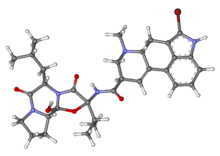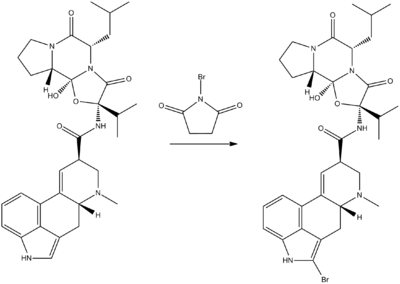Bromocriptine
Bromocriptine (originally marketed as Parlodel, subsequently under many names)[1] is an ergoline derivative and dopamine agonist that is used in the treatment of pituitary tumors, Parkinson's disease (PD), hyperprolactinaemia, neuroleptic malignant syndrome, and type 2 diabetes.
 | |
 | |
| Clinical data | |
|---|---|
| Trade names | Originally Parlodel, subsequently many[1] |
| Other names | 2-Bromoergocriptine |
| AHFS/Drugs.com | Monograph,International Drug Names |
| MedlinePlus | a682079 |
| Pregnancy category | |
| Routes of administration | oral, vaginal, intravenous |
| ATC code | |
| Legal status | |
| Legal status | |
| Pharmacokinetic data | |
| Bioavailability | 28% of oral dose absorbed |
| Metabolism | Extensively liver-mediated |
| Elimination half-life | 12-14 hours |
| Excretion | 85% bile (faeces), 2.5-5.5% urine |
| Identifiers | |
| |
| CAS Number | |
| PubChem CID | |
| IUPHAR/BPS | |
| DrugBank | |
| ChemSpider | |
| UNII | |
| KEGG | |
| ChEBI | |
| ChEMBL | |
| CompTox Dashboard (EPA) | |
| ECHA InfoCard | 100.042.829 |
| Chemical and physical data | |
| Formula | C32H40BrN5O5 |
| Molar mass | 654.606 g·mol−1 |
| 3D model (JSmol) | |
| |
| |
| (verify) | |
It was patented in 1968 and approved for medical use in 1975.[2]
Medical uses
Bromocriptine is used to treat acromegaly and conditions associated with hyperprolactinemia like amenorrhea, infertility, and hypogonadism, prolactin-secreting adenomas; it is also used to prevent ovarian hyperstimulation syndrome.[3][4][5]
It is also used to treat Parkinson's disease.[3]
Since the late 1980s it has been used, off-label, to reduce the symptoms of cocaine withdrawal but the evidence for this use is poor.[6]
A quick-release formulation of bromocriptine is also used to treat type 2 diabetes.[7][8][9]
Side effects
Most frequent side effects are nausea, orthostatic hypotension, headaches, and vomiting through stimulation of the brainstem vomiting centre.[10] Vasospasms with serious consequences such as myocardial infarction and stroke that have been reported in connection with the puerperium, appear to be extremely rare events.[11] Peripheral vasospasm (of the fingers or toes) can cause Raynaud's Phenomenon. Bromocriptine use has been anecdotally associated with causing or worsening psychotic symptoms (its mechanism is in opposition of most antipsychotics, whose mechanisms generally block dopamine receptors).[12] Pulmonary fibrosis has been reported when bromocriptine was used in high doses for the treatment of Parkinson's disease.[13]
Use to suppress milk production after childbirth was reviewed in 2014 and it was concluded that in this context a causal association with serious cardiovascular, neurological or psychiatric events could not be excluded with an overall incidence rate estimated to range between 0.005% and 0.04%. Additional safety precautions and stricter prescribing rules were suggested based on the data.[14][15] It is a bile salt export pump inhibitor.[16]
After long-term use of dopamine agonists, a withdrawal syndrome may occur during dose reduction or discontinuation with the following possible side effects: anxiety, panic attacks, dysphoria, depression, agitation, irritability, suicidal ideation, fatigue, orthostatic hypotension, nausea, vomiting, diaphoresis, generalized pain, and drug cravings. For some individuals, these withdrawal symptoms are short-lived and they make a full recovery, for others a protracted withdrawal syndrome may occur with withdrawal symptoms persisting for months or years.[17]
Pharmacology
Bromocriptine is a potent agonist at dopamine D2 receptors[18] and various serotonin receptors. It also inhibits the release of glutamate, by reversing the glutamate GLT1 transporter.[19]
Bromocriptine agonizes the following monoamine receptors:[20]
- Dopamine D1 family
- D1 (Ki=682 nM)
- D5 (Ki=496 nM)
- Dopamine D2 family
- D2 (Ki=2.96 nM)
- D3 (Ki=5.42 nM)
- D4 (Ki=328 nM)
- Serotonin 5-HT
- Adrenergic α family
- Adrenergic β family
Chemistry
Like all ergopeptides, bromocriptine is a cyclol; two peptide groups of its tripeptide moiety are crosslinked, forming the >N-C(OH)< juncture between the two rings with the amide functionality.
Bromocriptine is a semisynthetic derivative of a natural ergot alkaloid, ergocryptine (a derivative of lysergic acid), which is synthesized by bromination of ergocryptine using N-bromosuccinimide.[21][22]

History
Bromocriptine was discovered by scientists at Sandoz in 1965 and was first published in 1968; it was first marketed under the brand name Parlodel.[23][24]
A quick-release formulation of bromocriptine was approved by the FDA in 2009.[25]
Society and culture
As of July 2017, bromocriptine was marketed under many brand names worldwide, including Abergin, Barlolin, Brameston, Brocriptin, Brom, Broma-Del, Bromergocryptine, Bromergon, Bromicon, Bromocorn, Bromocriptin, Bromocriptina, Bromocriptine, Bromocriptine mesilate, Bromocriptine mesylate, Bromocriptine methanesulfonate, Bromocriptini mesilas, Bromocriptinmesilat, Bromodel, Bromokriptin, Bromolac, Bromotine, Bromtine, Brotin, Butin, Corpadel, Cripsa, Criptine, Criten, Cycloset, Degala, Demil, Deparo, Deprolac, Diacriptin, Dopagon, Erenant, Grifocriptina, Gynodel, kirim, Kriptonal, Lactodel, Medocriptine, Melen, Padoparine, Palolactin, Parlodel, Pravidel, Proctinal, Ronalin, Semi-Brom, Serocriptin, Serocryptin, Suplac, Syntocriptine, Umprel, Unew, Updopa, Upnol B, and Volbro.[1]
As of July 2017 it was also marketed as a combination drug with metformin as Diacriptin-M, and as a veterinary drug under the brand Pseudogravin.[1]
See also
References
- "Bromocriptine international brand names". Drugs.com. Archived from the original on 6 August 2017. Retrieved 13 July 2017.
- Fischer, Jnos; Ganellin, C. Robin (2006). Analogue-based Drug Discovery. John Wiley & Sons. p. 533. ISBN 9783527607495.
- "Bromocriptine mesylate tablets -- original uses" (PDF). FDA. January 2012. Archived (PDF) from the original on 2017-02-28. For label updates see FDA index page for NDA 017962 Archived 2017-06-29 at the Wayback Machine
- Molitch, ME (7 February 2017). "Diagnosis and Treatment of Pituitary Adenomas: A Review". JAMA. 317 (5): 516–524. doi:10.1001/jama.2016.19699. PMID 28170483.
- Tang, H; Mourad, S; Zhai, SD; Hart, RJ (30 November 2016). "Dopamine agonists for preventing ovarian hyperstimulation syndrome". The Cochrane Database of Systematic Reviews. 11: CD008605. doi:10.1002/14651858.CD008605.pub3. PMC 6465062. PMID 27901279.
- Minozzi, S; Amato, L; Pani, PP; Solimini, R; Vecchi, S; De Crescenzo, F; Zuccaro, P; Davoli, M (27 May 2015). "Dopamine agonists for the treatment of cocaine dependence". The Cochrane Database of Systematic Reviews (5): CD003352. doi:10.1002/14651858.CD003352.pub4. PMC 6999795. PMID 26014366.
- "Bromocriptine mesylate tablet label" (PDF). FDA. February 2017. Archived (PDF) from the original on 2018-05-13.. For label updates see FDA index page for NDA 020866 Archived 2017-06-28 at the Wayback Machine
- Garber, AJ; Blonde, L; Bloomgarden, ZT; Handelsman, Y; Dagogo-Jack, S (2013). "The role of bromocriptine-QR in the management of type 2 diabetes expert panel recommendations". Endocrine Practice. 19 (1): 100–6. doi:10.4158/EP12325.OR. PMID 23337160.
- Liang, W; Gao, L; Li, N; Wang, B; Wang, L; Wang, Y; Yang, H; You, L; Hou, J; Chen, S; Zhu, H; Jiang, Y; Pan, H (October 2015). "Efficacy and Safety of Bromocriptine-QR in Type 2 Diabetes: A Systematic Review and Meta-Analysis". Hormone and Metabolic Research = Hormon- und Stoffwechselforschung = Hormones et Metabolisme. 47 (11): 805–12. doi:10.1055/s-0035-1559684. PMID 26332757.
- Weil, C. (1986). "The safety of bromocriptine in long-term use: a review of the literature". Current Medical Research and Opinion. 10 (1): 25–51. doi:10.1185/03007998609111089. PMID 3516579.
- Iffy, L; McArdle, JJ; Ganesh, V; Hopp, L (1996). "Bromocriptine related atypical vascular accidents postpartum identified through medicolegal reviews". Medicine and Law. 15 (1): 127–34. PMID 8691994.
- Boyd, A. (1995). "Bromocriptine and psychosis: a literature review". The Psychiatric Quarterly. 66 (1): 87–95. doi:10.1007/BF02238717. PMID 7701022.
- Todman, D.; Oliver, W.; Edwards, R. (1990). "Pleuropulmonary fibrosis due to bromocriptine treatment for Parkinson's disease". Clinical and Experimental Neurology. 27: 79–82. PMID 2129961.
- "European Medicines Agency - News and Events - CMDh endorses restricted use of bromocriptine for stopping breast milk production". www.ema.europa.eu. 2018-09-17. Archived from the original on 2014-08-28.
- "EMA rät vom Abstillmittel Bromocriptin ab". 2014-08-25. Archived from the original on 2015-06-09. Retrieved 2014-08-26. "EMA rät vom Abstillmittel Bromocriptin ab", article in Ärzteblatt
- Montanari, Floriane; Pinto, Marta; Khunweeraphong, Narakorn; Wlcek, Katrin; Sohail, M. Imran; Noeske, Tobias; Boyer, Scott; Chiba, Peter; Stieger, Bruno; Kuchler, Karl; Ecker, Gerhard F. (2016). "Flagging Drugs That Inhibit the Bile Salt Export Pump" (PDF). Molecular Pharmaceutics. 13 (1): 163–71. doi:10.1021/acs.molpharmaceut.5b00594. PMID 26642869.
- Nirenberg MJ (2013). "Dopamine agonist withdrawal syndrome: implications for patient care". Drugs Aging. 30 (8): 587–92. doi:10.1007/s40266-013-0090-z. PMID 23686524.
- De Leeuw Van Weenen, J. E.; Parlevliet, E. T.; Maechler, P.; Havekes, L. M.; Romijn, J. A.; Ouwens, D. M.; Pijl, H.; Guigas, B. (2010). "The dopamine receptor D2 agonist bromocriptine inhibits glucose-stimulated insulin secretion by direct activation of the α2-adrenergic receptors in beta cells". Biochemical Pharmacology. 79 (12): 1827–36. doi:10.1016/j.bcp.2010.01.029. PMID 20138024.
- Shirasaki, Y; Sugimura, M; Sato, T (September 2010). "Bromocriptine, an ergot alkaloid, inhibits excitatory amino acid release mediated by glutamate transporter reversal". European Journal of Pharmacology. 643 (1): 48–57. doi:10.1016/j.ejphar.2010.06.007. PMID 20599932.
- National Institute ofMental Health. PDSD Ki Database (Internet) [cited 2013 Jul 24]. ChapelHill (NC): University of North Carolina. 1998-2013. Available from: "Archived copy". Archived from the original on 2013-11-08. Retrieved 2013-11-26.CS1 maint: archived copy as title (link)
- E. Fluckiger, A. Hofmann, U.S. Patent 3,752,814 (1973)
- A. Hofmann, E. Flueckiger, DE 1926045 (1969)
- Sneader, Walter; Corey, E. J. (2005). Drug Discovery: A History. John Wiley & Sons. p. 352. ISBN 9780471899792.
- Beekman, Andrew M.; Barrow, Russell A. (2014). "Fungal Metabolites as Pharmaceuticals". Australian Journal of Chemistry. 67 (6): 827. doi:10.1071/CH13639.
- Holt, RI; Barnett, AH; Bailey, CJ (December 2010). "Bromocriptine: old drug, new formulation and new indication". Diabetes Obes. Metab. 12 (12): 1048–57. doi:10.1111/j.1463-1326.2010.01304.x. PMID 20977575.
External links
- www.AcromegalyCommunity.com: Emotional and communal support for those touched by Acromegaly- page discussing drug, side effects, and prescription programs
- MedlinePlus DrugInfo medmaster-a682079
- https://www.drugs.com/pro/bromocriptine.html